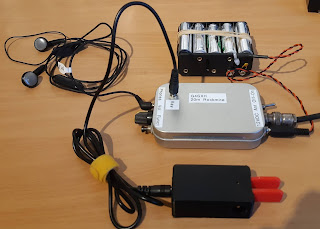 |
| Fig.1 - The finished transceiver with the lid open showing my crib sheet for the keyer commands |
Back in 2018 I built myself an HF transceiver based on the UBITX design. I fancied a self contained battery powered rig that I could use outdoors, so I made it portable. For fun I styled it as a suitcase radio, inspired by the radios used by the SOE in WW2. This also allowed plenty of room to make modifications in the future. I have made good use of the radio since and had a lot of fun with it.
https://www.myadventuresinengineering.com/p/blog-page.html
This Autumn I had a hiking trip coming up and decided that the suitcase radio would be far too big and heavy to take with me. After doing a bit of research I decided that a Rockmite would be a good radio for ultra-portable use, although, being a very low powered, fixed frequency, CW only radio, it cannot be compared with the UBITX!
The Rockmite is a simple crystal-controlled transceiver with a direct conversion receiver and a transmit power of a few hundred milliwatts. In addition to the crystal used in the oscillator there is a second, identical crystal which is used as a bandpass filter in the front end of the receiver. An unusual feature is that a PIC processor is used to provide TX/RX switching, iambic keying and sidetone. In the later versions the PIC includes the full functionality of the HamGadgets “picokeyer”.
I purchased the Rockmite II 20m transceiver kit from Kanga Products, the UK distributor for QRPme. I planned to build the radio into a small tin such as those that Altoids mints are sold in. However, Altoids mints are hard to find in the UK, so I settled on a similar sized unbranded tin I found on ebay.
Building the Rockmite
The kit contains no surface-mount components and the assembly was mostly straightforward. Before fitting the components, a PCB track needs to be cut and a link fitted on the underside of the PCB. This is presumably due to a PCB design fault. It is a shame that the PCB artwork has not been revised to remove the need for this extra assembly step. The kit is supplied with a few extra components for the various assembly options including volume control, speed potentiometer, power LED, reverse supply protection and alternative power amplifier options. I opted for the volume control and increased RF power output. I used a 10 ohm resistor for R18 and a 2N3053 for the output transistor. The kit came with two sets of crystals, 14.050 MHz and 14.060 MHz. I used sockets for the crystals to give me the option of operating on an alternative frequency. Fitting it all in the tin was a bit of a challenge, mainly due to the number of panel-mounted components and the very limited panel space.Testing
When first powered-up the radio could not be controlled properly. This was due to a faulty PIC which was not correctly programmed. A replacement PIC was obtained, and once fitted, the radio functioned correctly.The transmitter gives an output power of around 0.5W with a 13.8V supply and the receiver is reasonably sensitive. I found the receiver to be somewhat prone to hum, even with the radio powered from batteries. This can sometimes be a problem with direct conversion receivers. The hum disappears when the radio is being operated outside, away from buildings.
Operating
I have only had one actual contact with this radio so far, but reassuringly, CQ calls usually result in my signal being picked up by at least one station on the reverse beacon network (including Europe, USA and Canada) when the 20m band is open. I had a successful contact with an Italian station, at a distance of 907 miles (1451km), by answering his CQ call. We were both using simple wire aerials.
A rather neat feature of the Rockmite II is the built-in memory keyer. This has two programmable memories plus a host of other functions. I have both memories programmed with CQ calls, one for operating from the main station and one for portable operations.
Fig.2 shows the complete portable station. It is powered from 10 NiMH AA rechargeable cells. Since these cells can supply very high currents under fault conditions, I have included an RXEF020 PTC thermistor in series as a safety precaution. The mini twin paddle key was assembled from a kit obtained from a Chinese supplier. A full review of this can be found here.
 |
| Fig.2 - The complete ultra portable 20m station including battery pack, mini key and headphones |
Further Reading
Rockmite documentation:
https://qrpme.com/?p=product&id=RM4
Review and assembly details for mini key:
https://www.myadventuresinengineering.com/2020/10/review-of-chinese-twin-paddle-morse-key.html?m=1

Comments
Post a Comment